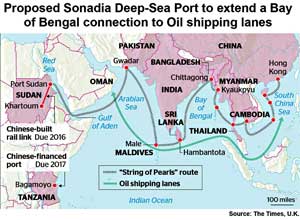A high-level Chinese delegation led by China’s Vice-Premier Madame Liu Yandong along with several other ministers are due to visit Dhaka next week on a specific bilateral mission. They will negotiate a comprehensive programme of further Chinese participation in the development agenda of Bangladesh, and sign a number of agreements for economic and human development cooperation.
Hopefully through the occasion of yearlong celebration of 40 years of China-Bangladesh diplomatic relations, before December this year, if we can be ready, Bangladesh may expect a higher level visit from the Prime Minister of China and reciprocal visit of Bangladesh Prime Minister to China to witness signing of a number of more agreements to build a development dynamics in our country at par with the momentum of South and Southeast Asian development dynamics unleashed by the Belt and Road Initiative of Chinese President Xi Jinping.
Regional dynamics & Bangladesh
Indeed the regional development dynamics in the Bay of Bengal belt obtained a sound impetus by the signing of the BCIM-EC (Bangladesh-China-India-Myanmar Economic Corridor) agreed in May, 2013 between Indian and Chinese Prime Ministers, and endorsed in December, 2013 in Joint Study Group meeting by Bangladesh and Myanmar; by the announcement of the Big-B initiatives (Bay of Bengal Industrial Growth Belt) by Japan in May 2014, followed by Japanese Prime Minister Abe’s visit to Bangladesh and Sri Lanka in September the same year; by the launching of the China-led Asian Infrastructure Investment Bank (AIIB) in Beijing in October, 2014; by the endorsement of Asia-Pacific leaders of the idea of Free Trade Area of the Asia and Pacific mooted at the APEC Summit in Beijing in November, 2014 by President Xi Jinping, and his announcement of the Belt and Road initiative as a blueprint for comprehensive connectivity with other continents; by the US-India Joint Strategic Vision statement by US President Obama and Indian Prime Minister Modi in January 2015 “to support sustainable, inclusive development, and increased regional connectivity by collaborating with other interested partners to address poverty and support broad-based prosperity”, and to “promote accelerated infrastructure connectivity and economic development in a manner that links South, Southeast and Central Asia”; and last but not the least by the “candid, constructive and friendly “discussions with President Xi and Premier Li of China by Prime Minister Modi of India who declared, “the re-emergence of India and China and their relationship will have a profound impact on the two countries and the course of this century”, and also declared the common intent “to strengthen regional connectivity”, during the latter’s 3-day visit to China this month. But are we, in Bangladesh, getting ready for the development drive adequately and fast enough?
Fatalistic nonchalance
Prime Minister Sheikh Hasina and most of her ministers are spending most of their time in opposition-bashing and in propaganda blitz about dynastic claims of her “right to rule” with unrestrained authoritarianism and abuse of coercive powers of the state. The administration is beset with corruption, nepotism, extortion, denial of justice, dereliction of duty and indecision, hampering growth and depriving common people of the fruits of gigantic efforts they are making in productive activity.
Those in power appear to have a fatalistic nonchalance taking it for granted that Almighty Allah, who has granted them the divine license to suck up the milk and honey of their domain, would somehow manage to look after the country people, and big powers in the geo-political game of the region will take care of the nation’s drift towards chaos. Contemporary situation in the Middle East, Africa and Ukraine suggest that such callousness and wishful thinking may very well result in blood-bath, long drawn conflicts, and suicidal mass exodus leading to nowhere with abysmal human misery. Even if such critical stage of national dismemberment does not arise, in the immediate term we may stand to lose appropriate development cooperation that is now on the table to negotiate.
One example of warped thinking can be cited with regard to Sonadia Deep Sea Port project, the decision over which successive governments have been sitting on for over a decade now.
Misguided strategic blunder
Our bureaucratic elite, partly misguided by Western strategic analysts who linked the Chinese offer on the project to a “string of pearls” policy of oceanic connectivity of Chinese naval power projection to ensure an alternative sea-route for Middle Eastern oil and gas supply to China avoiding the stranglehold of Malacca straits (vide Map A), preferred to sit tight with the thought that the Chinese will pursue the project in good time in their own interest. In private, Chinese representatives in several seminars have been warning that other alternatives to Sonadia are available in the Bay of Bengal littorals grounds to China for their oil and gas supply transportation by sea, and of course China is getting gas and oil from Central Asian fields and from Russia by direct pipeline connections.
In fact, in the Bay of Bengal theatre too, China has already completed gas and oil pipeline connection from Shwe marine gas field of Myanmar to Kunming and Nanning in Northwest China through Myanmar territory (vide Map B), rendering Sonadia deep sea port project redundant for oil and gas transportation to China from the Gulf region over a roundabout sea route.
Development of Sonadia Deep Sea Port (or its possible alternative at Matarbari in the same environment of Cox’s Bazar-Chittagong Development zone) is very important for the long-term development of Bangladesh and the sub-Himalayan region beyond. It has prospects of a natural hub for connectivity with Northeast India, Bhutan, Nepal and Tibet, on to Myanmar ports, Thailand, Sri Lanka and beyond. But it is our leadership that has to peruse it and to qualify for direct foreign assistance from China and other possible partners including India and the US, and for investment funds committed to infrastructure building like the AIIB.
Source: Weekly Holiday

